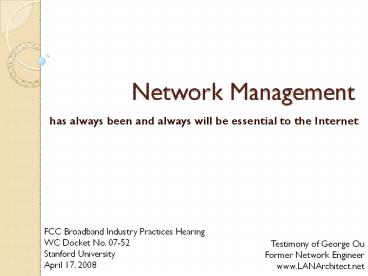Network Management - PowerPoint PPT Presentation
Title:
Network Management
Description:
Lack of adequate congestion control in TCP allowed too many FTP users to ... Vonage or Lingo SIP-based VoIP service with G.726 codec _at_ 32 kbps payload and ... – PowerPoint PPT presentation
Number of Views:35
Avg rating:3.0/5.0
Title: Network Management
1
Network Management
- has always been and always will be essential to
the Internet
FCC Broadband Industry Practices Hearing WC
Docket No. 07-52 Stanford University April 17,
2008
Testimony of George Ou Former Network
Engineer www.LANArchitect.net
2
Internet meltdown in 1980s
- Lack of adequate congestion control in TCP
allowed too many FTP users to overload Internet
around 1986 - Van Jacobson created congestion control algorithm
for TCP in 1987 - Congested routers randomly dropped packets to
force every TCP end-point (client) to cut flow
rate in half - TCP clients then slowly increased flow rate with
every successful transmission until next packet
drop - Caused all TCP streams to home in towards equal
flow rate - Fair bandwidth sharing, but only for applications
of its time - Jacobsons algorithm saved the Internet in 1987
and remains dominant standard after 20 years - Early example of managing network congestion
3
World Wide Wait in 1990s
- First generation of web browsers were not
optimized for Internet - World Wide Web turned in to theWorld Wide Wait
- Version 1.1 of HTTP revamped to efficiently use
resources over 1.0
4
Todays crisis on the Internet
- Video-induced congestion collapse
- Efficient existing broadcast model migrating to
bandwidth-intensive Video on Demand model over IP - Full migration of video could require 100- to
1000-fold increase in Internet capacity - Exponentially more bandwidth required as video
bit-rate and resolution increase to improve
quality - P2P is the dominant distribution model because
most of its content isfree (read pirated) - Video can fill any amount of bandwidth
5
More bandwidth doesnt help
The few throttling the many
According to the Japanese Government 1 of users
account for 47 of traffic 10 of users account
for 75 of traffic 90 of users get leftover 25
6
Exploiting Jacobsons algorithm
50/50 Fair
80/20 Unfair
92/8 Unfair
7
Persistence advantage in P2P apps
Corporate VPN telecommuter worker using G.722
codec _at_ 64 kbps payload and 33.8 kbps
packetization overhead Vonage or Lingo
SIP-based VoIP service with G.726 codec _at_ 32 kbps
payload and 18.8 kbps packetization
overhead I calculated that I sent 29976
kilobytes of mail over the last 56 days averaging
0.04956 kbps
8
Weighted TCP Per-user fairness
92/8 Unfair
50/50 Fair
- BT chief researcher Bob Briscoe proposes TCP fix
before the IETF to neutralize multi-stream
loophole - Changing TCP takes many years, but its even
harder to get over a billion devices to switch to
new TCP client - Newer network-based solutions being implemented
9
Present and future solutions
- Present solutions use protocol throttling
- P2P applications use disproportionately large
amounts of bandwidth so theyre throttled to
balance them out - Use conventional router de-prioritization
techniques on P2P - Use TCP resets to occasionally stop P2P seeders
- Potentially affect an extremely rare
low-bandwidth P2P user - Can be fooled by protocol obfuscation techniques
- Future solutions are protocol-agnostic
- Weighted packet dropping at router and/or fair
upstream scheduling on CMTS accomplishes per-user
fairness - Only targets bandwidth hogs and forces them to
back off - Cannot be fooled by protocol obfuscation
10
What is reasonable network management?
Protocol-agnostic per-user fairness
Fair
Future
Intelligent
Reasonable
ISP throttles BW hogging protocols
Metered Internet
Unreasonable
No network management
Unfair
Dumb
Past
11
Network management ensures harmonious coexistence
- P2P applications need volume, not priority
- Interactive applications (Web) and real-time
applications (VoIP) want priority and not volume - P2P, Interactive, and real-time applications each
get what they want under a managed network - Interactive and real-time apps have small/fixed
volume so no matter how much theyre prioritized,
they cannot slow down a P2P download. - Unmanaged networks regardless of capacity will
always be unfair and hostile to interactive and
real-time applications































